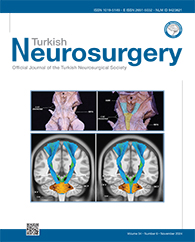2State University of Ponta Grossa, Faculty of Medicine, Ponta Grossa - Paraná, Brazil
3Rusk Rehabilitation, NYU Langone Health, New York - New York, United States
4University of São Paulo, Department of Neurosurgery, São Paulo - São Paulo, Brazil DOI : 10.5137/1019-5149.JTN.46167-23.2 AIM: To evaluate the usage and the effectiveness of LVIS Jr device technology in managing wide-neck intracranial aneurysms.
MATERIAL and METHODS: PubMed, Embase, and Web of Science databases, comprising studies with outcomes related to LVIS Jr use in wide-neck intracranial aneurysms were searched systematically. Data was extracted from the selected articles and subjected to statistical analysis.
RESULTS: Among 886 initially identified articles, 20 studies met our inclusion criteria, comprising a total of 557 patients. Our analysis revealed a 96% final occlusion rate under common effects and 93% under random effects, with substantial heterogeneity (I² = 69%). Good clinical outcomes were observed in 99% of cases with low heterogeneity (I² = 27%). Mortality rates were extremely low, with only one reported death out of 499 patients across 18 studies, resulting in a 0% mortality rate for common and random effects and no heterogeneity (I² = 0). Complications occurred in 44 of 482 patients, yielding a 6% rate in the common effect model and 6% in the random effects model, with nonsignificant heterogeneity (I² = 25%).
CONCLUSION: LVIS Jr observed a favorable rate of final occlusion and good clinical outcomes, and the low mortality and complication rates highlight its safety in the treatment of wide-neck aneurysms.
Keywords : Wide-neck, Aneurysm, Stent, LVIS Jr




